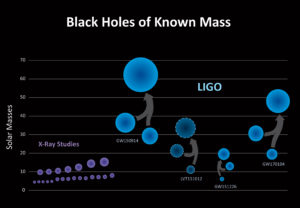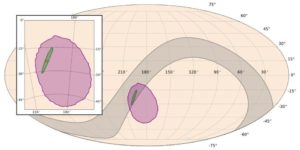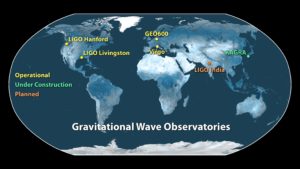Peter Lobner
The Laser Interferometer Gravitational-Wave Observatory (LIGO) in the U.S. reported the first ever detection of gravitational waves on 14 September 2015 and, to date, has reported three confirmed detections of gravitational waves originating from black hole coalescence events. These events and their corresponding LIGO press releases are listed below.
- GW150914, 14 September 2015
https://www.ligo.caltech.edu/page/press-release-gw150914
- GW151226, 26 December 2015
https://www.ligo.caltech.edu/page/press-release-gw151226
- GW170104, 4 January 2017
https://www.ligo.caltech.edu/page/press-release-gw170104
The following figure illustrates how these black hole coalescence events compare to our knowledge of the size of black holes based on X-ray observations. The LIGO team explained:
“LIGO has discovered a new population of black holes with masses that are larger than what had been seen before with X-ray studies alone (purple). The three confirmed detections by LIGO (GW150914, GW151226, GW170104), and one lower-confidence detection (LVT151012), point to a population of stellar-mass binary black holes that, once merged, are larger than 20 solar masses—larger than what was known before.”
 Image credit: LIGO/Caltech/MIT/Sonoma State (Aurore Simonnet)
Image credit: LIGO/Caltech/MIT/Sonoma State (Aurore Simonnet)
On 1 August 2017, the Advanced VIRGO detector at the European Gravitational Observatory (EGO) in Cascina, Italy (near Pisa) became operational, using wire suspensions for its interferometer mirrors instead of the fragile glass fiber suspensions that had been delaying startup of this detector.
On 17 August 2017, the LIGO – VIRGO team reported the detection of gravitational waves from a new source; a collision of two neutron stars. In comparison to black holes, neutron stars are low-mass objects, yet the neutron star collision was able to generate gravitational waves that were strong enough and in the detection frequency range of the LIGO and VIRGO. You’ll find the LIGO press release for that event, GW170817, at the following link.
https://www.ligo.caltech.edu/page/press-release-gw170817
The following figure from this press release illustrates the limits of localizing the source of a gravitational wave using the gravitational wave detectors themselves. The localization of GW180817 was much better than the previous gravitational wave detections because the detection was made by both LIGO and VIRGO, which have different views of the sky and a very long baseline, allowing coarse triangulation of the source.
 Gravitational wave sky map. Credit__LIGO_Virgo_NASA_Leo_Singer__Axel_Melli
Gravitational wave sky map. Credit__LIGO_Virgo_NASA_Leo_Singer__Axel_Melli
Unlike the previous gravitational wave detections from black hole coalescence, the neutron star collision that produced GW180817 also produced other observable phenomena. Gravitational waves were observed by LIGO and VIRGO, allowing coarse localization to about 31 square degrees in the sky and determination of the time of the event. The source of a two-second gamma ray burst observed at the same time by the Fermi and INTEGRAL gamma ray space telescopes (in Earth orbit) overlapped with the region of the sky identified by LIGO and VIRGO. An optical transient (the afterglow from the event) in that overlap region was first observed hours later by the 1 meter (40 inch) Swope Telescope on Cerro Las Campanas in Chile. The results of this localization process is shown below and is described in more detail in the following LIGO press release:
https://www.ligo.caltech.edu/news/ligo20171016
The sky map created by LIGO-Virgo (green) showing the possible location of the source of gravitational waves, compared with regions containing the location of the gamma ray burst source from Fermi (purple) and INTEGRAL (grey). The inset shows the actual position of the galaxy (orange star) containing the “optical transient” that resulted from the merger of two neutron stars (Credit: NASA/ESO)
The specific source initially was identified optically as a brilliant blue dot that appeared to be in a giant elliptical galaxy. A multi-spectral “afterglow” persisted at the source for several weeks, during which time the source became a dim red point if light. Many observatories were involved in detailed observations in the optical and infra-red ranges of the spectrum.
Important findings relate to the formation of large quantities of heavy elements (i.e., gold to uranium) in the aftermath of this event, which is known as a “kilonova.” This class of events likely plays an important role in seeding the universe with the heaviest elements, which are not formed in ordinary stars or novae. You’ll find more details on this matter in Lee Billing’s article, “Gravitational Wave Astronomers Hit the Mother Lode,” on the Scientific American website at the following link:
https://www.scientificamerican.com/article/gravitational-wave-astronomers-hit-mother-lode1/
The ability to localize gravitational wave sources will improve as additional gravitational wave detectors become operational and capabilities of existing detectors continue to be improved. The current status of worldwide gravitational wave detector deployment is shown in the following figure.
The ability to take advantage of “multi-messenger” (multi-spectral) observations will depend on the type of event and timely cueing of observatories worldwide and in orbit. The success of the GW170817 detection and subsequent multi-spectral observations of “kilonova” demonstrates the rich scientific potential for such coordinated observations

